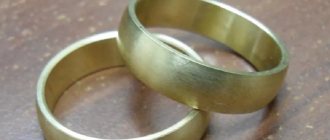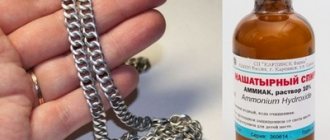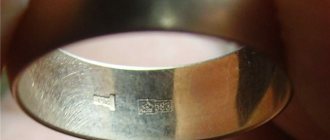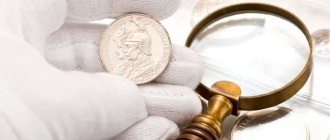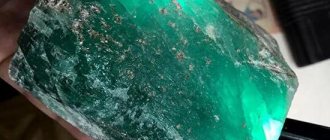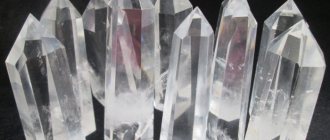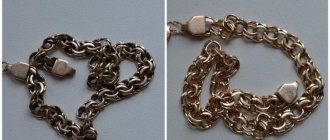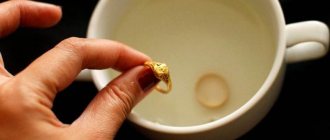Hello! Today is an interesting and educational topic. We talk about how to distinguish gold from fake.
Most people know that a precious metal like gold is characterized by its fineness. A stamp is applied to jewelry. When purchasing, everything seems obvious. There are identification marks. Therefore, you can safely take it.
Having visited the service, any jeweler will notice a fake. In fact, it will be an alloy or gilding.
It is important to understand that gold is not used in its pure form. The metal is too soft. Therefore, other metals are added to the composition for strength. This is determined by the test.
But there are outright fakes. We will deal with them.
Historical summary
Humanity first learned about gold in the Bronze Age. The main mining sites were located in Ancient Egypt and Mesopotamia. In antiquity, a sacred belief in gold appeared. Many believed that this metal was formed by solar power and could endow a person with it. This metal represented wealth and high status.
Dramatic changes in the world economy occurred in the 18th century. From that period, the development of gold mines began:
- Brazil - 1700.
- California - 1848.
- Australia - 1850.
- Canada - 1896.
What do the marks 750, 585 and 417 mean on gold jewelry?
What is gold purity?
If you have gold jewelry, you may notice that it has a small number stamped on it. Experienced gold buyers know exactly what these numbers mean, and they use this information when determining how much they will pay for any piece of jewelry.
Here's a quick guide to these gold tags.
Deposits and production
Leaders in production:
- China.
- Australia.
- Russia.
- USA.
- Canada.
- SOUTH AFRICA.
- Peru.
- Uzbekistan.
- Mexico.
- Ghana.
According to statistics, by 2014, 2809.5 tons of precious metal were mined in the world.
Statistics for Russia (Photo: Instagram / techade.ru)
Properties
To understand where a precious metal can be used, you need to study its basic properties - chemical, physical, optical, crystallographic.
Chemical
Gold is a chemical element of the first group of the periodic table. Its atomic number is 79. Valence in chemical compounds is +1, +3. Gold is not affected by sulfur or oxygen, but this noble metal is not inert. When heated to 700°C, an oxide film is formed on the surface, which does not collapse with further heating for 12 hours.
Physical
Properties:
- Color - white-yellow with silver veins or rich yellow.
- Transparency is an opaque material.
- Shine is present.
- Density - up to 19.3 g/cm3.
- Hardness index on the Mohs scale - up to 3.
- Radioactivity - 0.
Gold is diamagnetic.
Optical
Properties:
- Type - isotropic.
- The color in reflected light is reddish or yellow, which turns into white.
- The noble metal is not fluorescent.
- Gold does not pleochroate.
Rings made of red and white gold (Photo: Instagram / dreams_krsk)
Crystallographic
Properties:
- Cubic system.
- Space group - Fm3m.
- Point group - m3m.
What is gold
In its pure form, gold is a shiny metal with a bright yellow color. Number 79 of the periodic table, international designation – Aurum (Au). One of the most “massive” but soft metals with a cubic lattice structure centered on the faces.
The name in modern languages goes back to a Proto-Indo-European root meaning “yellow, green, bright.” The Latin name, given in honor of the goddess of the dawn, Aurora, is also translated as “yellow”.
Gold crystals grown by chemical transport
Classification
Gold can be divided into different types depending on the method of extraction, purpose, purity, origin, color.
By extraction method
Kinds:
- Placer. There are such mines in every gold-bearing province in the world. Gold represents destroyed endogenous deposits that have been deformed under the influence of environmental factors.
- Rudnoye. It is indigenous gold, formed as a result of magmatic processes that previously occurred in the earth's crust.
Placer gold (Photo: Instagram / mad.gold.miner)
By cleanliness
Until the beginning of the 20th century, each country assessed the quality and purity of precious metals in its own way. There are now two recognized sampling systems that are used in different countries around the world. The CIS countries and Russia typically use the metric system, while Europe and the USA use the carat system.
By purpose
Kinds:
- Medical. Alloys used in two areas - dentistry and pharmacology. Crowns and dentures are made from the noble metal, and alloy particles are added to medications.
- Technical. Used for the manufacture of printed circuit boards, electrical contacts, connectors.
- Investment. Pure gold, which is deposited in the reserve reserves of the country where it was mined.
- Jewelry. Gold used to make jewelry. Since pure metal is very brittle, it is mixed with alloying additives.
A separate type is red gold. Previously, coins (chervonets) were made from it.
By color
Kinds:
- Red. Obtained when mixed with copper. The color saturation depends on its quantity.
- White. It is believed that gold gets its color due to the addition of silver, but this is a misconception. It turns white due to the addition of palladium and platinum.
- Yellow. Classic shade. The composition of the metal is similar to red gold, but the components of the composition are selected in an even ratio.
There is also green, purple, blue, black, brown, pink, lemon, amethyst and gray gold.
When prospectors discover gold-bearing veins, the first thing they notice is greenish-gray or dull yellow crystals.
Rings and earrings made of black gold (Photo: Instagram / olga.shatrova)
By origin
Kinds:
- Chinese. Sample for making jewelry - 720.
- Italian. This region is characterized by the use of white, rose or yellow gold for jewelry making.
- Russian. Alloys that are put on sale must comply with a number of state standards. The quality of the metal is high.
- Arabic. The decorations stand out with rich shades and brightness. This is due to the high quality of noble metals.
- Turkish. Turkey does not mine gold, since there is no gold deposit on its territory, but buys the precious metal from other countries.
TOP world manufacturers
Every country where jewelry production exists has its own market leaders. However, only a few brands have worldwide fame and a name that almost everyone knows. We did not try to rank these manufacturers, since each of them is a kind of legend. So in this case we are not presenting a rating, but a general review, the participants of which are placed in it without any order.
Cartier
The French brand, which produces jewelry and watches, has existed for more than 150 years.
- In this family business, which began with a small private workshop, the art of jewelry is passed on from the older generation to the younger, keeping its traditions unshakable
- The worldwide fame of its founder was ensured by the production of crowns for many European monarchs.
- In the 2021 season, he released a fashion collection combining gold and enamel.
Boucheron
Over the course of its one and a half century existence, this brand, which appeared in France, has gained worldwide fame and recognition. Specialization: jewelry and glasses.
- The uniqueness of the brand lies in the combination of precious stones of different colors and oriental motifs.
- The creator of this jewelry business knew a lot about advertising - he always chose only sunny rooms for the presentation of diamonds
- The world-famous product of this brand is a white gold bracelet in the shape of a snake, with diamonds.
Tiffany
American company founded more than 180 years ago. The range includes not only jewelry, but also silverware, crystal and porcelain items, perfumes and stationery.
- Wedding rings have become the trademark of the brand.
- The turquoise blue color is a distinctive feature of the brand and is registered as a trademark
- World fame with Audrey Hepburn
If you want to pamper yourself or give a luxurious gift to a loved one, pay attention to platinum jewelry. Read and choose the best platinum jewelry - TOP 5 world brands →
Bulgari
The Italian brand, which is more than a hundred years old, has become famous not only for its unique design, but also for its leather accessories and perfumes.
- The brand name is written with a change from U to V, since this style of writing is inherent in the Latin alphabet
- In fact, the founder of the company is a Greek, who moved under the pressure of the Turks who were at war with Greece, first to Corfu, then to Naples, and then to Rome
- In addition to jewelry, a chain of hotels successfully operates under this brand
Harry Winston
A ninety-year-old US brand known for its diamonds and luxury watches.
- The founder of the brand named after him had the title “King of Diamonds”
- Developed an innovative technology for fixing stones, which allows you to combine stones with different types of cuts in jewelry
- It was this company that became a pioneer in the rental of jewelry for social events (for example, the Oscars ceremony).
Gucci
An Italian brand whose history began at the end of the 19th century with the production of wicker straw hats. Gucci later worked on leather, accessories, handbags and much more.
- They were known primarily as clothing manufacturers, but over the past 30 years they have successfully conquered a niche in the jewelry market.
- Famous for using unexpected colors and combinations of materials in jewelry (for example, precious metal and ebony)
- They experienced a crisis in the second half of the twentieth century, from which the brand was helped to emerge by Tom Ford, who returned gold jewelry to fashion
Areas of application
Areas of application:
- Jewelry making.
- Dentistry.
- Chemical, mechanical industry.
- Electronics.
- Food industry.
- Pharmacology.
Gold reserves fuel paper denominations. In the past, precious metal coins were used as money.
Less popular areas of application of the noble metal are energy, nanotechnology, aviation, and the space industry.
Gold coins (Photo: Instagram / mosdragmet)
What impurities can be added to the alloy?
Impurities that manufacturers and jewelers can add to change the color, properties, and technical characteristics of the metal are copper, silver, platinum, zinc, nickel, manganese, palladium, cadmium, aluminum.
Sample measurement systems
There are 4 recognized sample measurement systems in the world. One part of them is still in use today, the other has long lost popularity.
Zolotnikovaya
Used on the territory of the Russian Empire and the USSR until 1927. One pound of pure gold at that time consisted of 96 spools. By testing it was possible to find out how many spools were contained in one pound of alloy.
Metric
A popular system that is still used today. Using the metric standard, you can find out the weight amount of gold in 1000 parts by weight of the alloy.
Lotovaya
Previously it was popular in Western European countries. Not currently used. Previously, the mass of gold and silver was determined by marks. The number of lots per 1 brand of alloy indicated the amount of pure noble metal.
Carat
This system is popular in some European countries and the USA. The alloy is divided into 24 parts. Fineness is the number of parts of pure noble metal out of the total.
Gold bars
Today, the popularity of investing in gold bullion has grown; it is a reliable way to invest in a volatile economy and also helps to earn money. The bars are manufactured in accordance with the high requirements of the English Bullion Association. There are two types of gold bars:
- Measured. They are sold in Russia and contain 99.9% gold, respectively, the fineness of this metal is 999. The maximum weight of the ingot is 1 kg, but the length, width, and thickness are allowed to vary. A stamp with the number of the manufacturer and a trademark are placed on the surface of the ingot, which indicates authenticity. The ingot is accompanied by a quality certificate.
- Standard. Manufactured under the strictest control and according to international standards. It has the shape of a pyramid, without impurities. The ingot is marked with a number, hallmark and factory mark. The weight of such an ingot is 11–13 kg and is sold to processing enterprises.
There are two methods for making gold bars: casting and stamping. The first, cheaper one, is used for casting large ingots. The second method is expensive and uses it to make ingots up to 0.5 kg.
Types of samples
Samples:
- 999. Most expensive. Elite jewelry is made from such alloys. They contain a minimal amount of foreign impurities. More often used for the production of bank bullion.
- 958. Russian jewelers practically do not use it to make precious items. On the market you can find jewelry with this hallmark from Arab manufacturers.
- 750. Used to make jewelry with precious stones.
- 585. Used for making any jewelry - rings, church utensils, ties, crosses, earrings.
- 583. Gave way to 585 sample in 2000.
The cheapest standard is 375. The composition contains 37.5% gold, the rest is copper and silver.
Golden cross (Photo: Instagram / adamant_heart)
Verification methods
To choose the best option for yourself, let’s look at 12 ways to identify fake gold.
Some methods are used at home. Others can be used when choosing precious items.
Studying the sample
One of the options on how to distinguish white gold from a fake. Also relevant for ordinary yellow precious metal.
Factory products are always supplemented with a stamp with a sample. The fineness determines the number of grams of pure precious metal in the alloy. And the lower the sample, the worse the product itself will be.
A government decree of 2021 established that all alloys where more than 30% of the mass is precious metal must be branded and also indicate the fineness.
The following tests exist:
- 375;
- 500;
- 583;
- 585;
- 750;
- 916;
- 958;
- 999.
999 sample is the highest quality. Here, per 1 kilogram of precious metal there is only 1 gram of impurities.
But these are Russian standards.
Products can also be imported from other countries.
Let's consider several options.
For example, the USA and Canada. They use carat classification of samples. Here, 9 carats is 375 carats, and 999 carats is designated as 24 carats.
Look at the letter K next to the number. It indicates that the product is made of gold. If you see the letters KGP, then there is only a gold plated coating.
Belgian manufacturers have a different classification:
- number 1 indicates sample 833;
- number 2 marks products of 750 standard;
- if there is 3, then it will be 585 sample.
Similar classification systems are in Slovakia and the Czech Republic. Only here 0 is 99, 1 indicates 986, and 2, 3 and 4 are 900, 750 and 585, respectively.
The difficulty is that the sample is applied finely. You have to use a magnifying glass, or use a smartphone with a good camera.
Study the sample in detail. It should be clear, without bending or blurring. Feel free to ask for a product passport. If it's not there, leave the store.
What a smell
Remember a simple rule.
Products made from real gold have no odor.
Compare even with the same silver. Silver has its own characteristic metallic aroma. Gold shouldn't smell like anything.
Joints
It is also worth studying the joints if these are bracelets or chains.
Take a closer look at the shades of the joint, as well as the link. The difference in shade is due to the fact that solder of a higher standard is used for soldering gold jewelry. This is explained by the fact that such material melts more easily.
That is, the color difference will be considered a normal phenomenon. This is a sign of real gold. If there is no difference, then it is worth checking additional characteristics.
Using a magnet
A popular solution is to coat steel, as well as other alloys, with gold or imitation.
Strong magnetization is characteristic only of ferromagnets. These include:
- cobalt;
- nickel;
- iron;
- terbium;
- gadolinium;
- dysprosium;
- erbium;
- thulium, etc.
But there are paramagnetic materials such as aluminum. They are slightly magnetic.
All types of non-ferrous metal are not subject to magnetization.
You can check the product with any inexpensive magnet. Even the ones used in souvenirs.
If the magnet sticks, then it is a fake. Or the percentage of iron content is high, but there is practically no gold.
If it does not stick, then you should check it in other ways.
Vinegar test
Tell the seller that you want to test the product with vinegar.
The scammers will start to get noticeably nervous. You don't even have to go get vinegar. Everything is clear.
When there is no doubt about quality, then there is nothing to be afraid of.
The caveat is that when placed in vinegar, gold begins to quickly darken. Literally 3-5 minutes is enough to identify a fake.
The precious metal will not enter into any reaction.
What does iodine do?
There is one more test. You need to rub the product on a thick cloth. Like jeans. Then drop a little iodine onto this area of the product. If it is a high standard of real gold, then the metal is not darker.
If the metal is darkened, then it is a fake. Or the sample is low.
Just keep in mind that this method will not work with copper and brass.
It is not recommended to test products with a sample level of 585 or lower with iodine. Otherwise you will have to polish the products. Traces may remain.
lapis pencil
In medicine it is used to stop bleeding. The antiseptic contains silver nitrates. Sold in any pharmacy.
To check a gold item, you need to soak it in water. Then draw a line on the wet object and wipe it off with a napkin.
Lapis does not react to gold. But it reacts with other types of metals. If the trace remains, then the gold is of low quality or of questionable quality. High-quality products do not react at all.
Sun and shadow
Items made of high-quality gold will shine equally in the shade and in the sun. Try looking at them in different lighting.
For clarity, you can take an object that is precisely made of precious metal. And compare how intensely they shine in the sun.
Black bread
It may seem strange to some, but gold is also tested by black bread.
The method is as safe as possible, but time-consuming. You need a crumb of bread that is kneaded and also mixed with water. Then the product is covered with this mixture and left for some time. The crumb should become dry.
Look what's inside the bread. If dark traces appear there, then an oxidation process has occurred. If there are no traces, then the item is of high quality. Or it's very good gilding.
Tile or unglazed porcelain
You should run a gold object over them.
Porcelain without glaze, as well as unfired ceramic tiles, are covered with gold when applied with gold. Counterfeits will leave a gray or black mark.
You just need to draw with those parts that you don’t mind slightly damaging.
If the tile is fired, then there will be no traces left at all.
Pawn shop help
To avoid having to deal with different tests, just go to a pawn shop with a potentially gold item.
Ask for an assessment. The service is inexpensive. Some even evaluate for free. Especially if you pretend to be a client who wants to hand over the jewelry.
The professionals work there. They will quickly determine whether it is a copy or not.
Jeweler's advice
Jewelers can visually identify a fake and also conduct tests using special equipment.
Moreover, the devices show not only quality, but also genuine sample.
Again, there may be a charge for the service.
How to determine the sample?
To determine the sample at home, you need to prepare:
- aqua regia;
- assay needles;
- nitric acid,
- chlorine gold.
How to check gold:
- Apply gold chloride to the surface.
- Wait a while.
Result:
- If after 2 seconds there is no change, the sample is either 585 or higher.
- Darkening of the metal indicates low quality of the alloy - the compound contains a large amount of copper, silver, and brass.
- If after 5 minutes a chestnut-colored spot appears at the site where the solution was applied, the sample is below 583.
Product care
To avoid damage to products, you must:
- Remove jewelry before cleaning, washing dishes, or visiting a bathhouse or sauna.
- Store products in a special case or fabric bag.
- At the end of each day, remove jewelry and wipe it with a dry cloth or napkin.
- Protect the product from contact with cosmetics and perfume.
If you need to clean gold from plaque or darkening, you can use home methods, specialized cleaning products, or take the jewelry to a specialized workshop.
Gold is a precious metal used in various fields of activity. Its popularity is explained by its attractive appearance, properties, and technical characteristics. By adding other metals, the characteristics and properties of the alloy can be changed.
